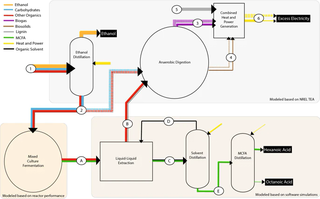Increasing the economic value of lignocellulosic stillage through medium-chain fatty acid production
M. J. Scarborough et al. (2018). Increasing the economic value of lignocellulosic stillage through medium-chain fatty acid production. Biotechnology for Biofuels 11:200
Background
Lignocellulosic biomass is seen as an abundant renewable source of liquid fuels and chemicals that are currently derived from petroleum. When lignocellulosic biomass is used for ethanol production, the resulting liquid residue (stillage) contains large amounts of organic material that could be further transformed into recoverable bioproducts, thus enhancing the economics of the biorefinery.
Results
Here we test the hypothesis that a bacterial community could transform the organics in stillage into valuable bioproducts. We demonstrate the ability of this microbiome to convert stillage organics into medium-chain fatty acids (MCFAs), identify the predominant community members, and perform a technoeconomic analysis of recovering MCFAs as co-products of ethanol production. Steady-state operation of a stillage-fed bioreactor showed that 18% of the organic matter in stillage was converted to MCFAs. Xylose and complex carbohydrates were the primary substrates transformed. During the MCFA production period, the five major genera represented more than 95% of the community, including Lactobacillus, Roseburia, Atopobium, Olsenella, and Pseudoramibacter. To assess the potential benefits of producing MCFAs from stillage, we modeled the economics of ethanol and MCFA co-production, at MCFA productivities observed during reactor operation.
Conclusions
The analysis predicts that production of MCFAs, ethanol, and electricity could reduce the minimum ethanol selling price from $2.15 to $1.76 gal−1 ($2.68 gal−1 gasoline equivalents) when compared to a lignocellulosic biorefinery that produces only ethanol and electricity.
The raw sequencing reads from 16S rRNA gene amplicon sequencing are available under NCBI BioProject ID PRJNA393345 (252-day experiment) and NCBI BioProject ID PRJNA432807 (6-day experiments). Stillage and reactor data are available in Additional file 1 and data used for the TEA are provided in Additional file 3.
